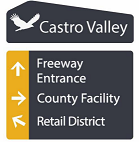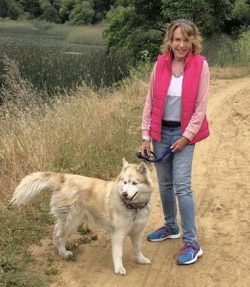It’s time to be creative with sidewalk construction policies
- By : Michael Kusiak
- Category : Economic Development, Public Safety

Looking around my central Castro Valley neighborhood, while we’re lucky to have continuous sidewalks on both sides of my street, they could use a little TLC.
Well-maintained sidewalks in central Castro Valley are a smart investment in safety that enhances walkability in an area of town that hosts our BART station, library, and central business district. I hope that there will be lots of talk about improving sidewalks at today’s Walk/Bike Castro Valley Town Hall, hosted by Supervisor Nate Miley.
Within the past year, BikeWalkCV established itself, and working with Supervisor Miley hosted a community town hall on pedestrian and bike issues last October. Last week, Alameda County held the first meeting of the Castro Valley Bicycle and Pedestrian Advisory Committee (CVBPAC). Castro Valley is finally having a meaningful public conversation about the state of our pedestrian and bicycling infrastructure.

On my street in particular, rolling curbs create an undefined boundary between the street and sidewalk, resulting in parked cars on the sidewalk that block pedestrian access and damage sidewalks. Unrepaired sidewalks make it difficult for the elderly and parents pushing strollers…or anyone who doesn’t want to trip.
So how do you fix a sidewalk in Castro Valley?
How does Alameda County support sidewalk construction?
Funded by Measure B, the Safe Routes to School Program, and other grant programs, the Sidewalk Construction and Sidewalk Repair programs serve as Alameda County’s primary vehicles to support sidewalks in the unincorporated communities. Last November’s approval of Measure BB will likely provide additional funds for these programs; Wednesday’s town hall will include a presentation from the Alameda County Transportation Commission on how Measure BB funds could be spent in Castro Valley.
Under the Sidewalk Construction program, priority has been given to projects around schools:
Roadways were ranked according to criteria based on proximity to schools, collision history, pedestrian generators, and feasibility. Preference was given to pedestrian improvements in school zones, specifically for children walking and biking to and from school

While many California cities do repair some types of sidewalks damage (the City of Alameda repairs sidewalks damaged by the roots of street trees “as a courtesy”), under California Street and Highway Code, property owners are responsible for maintaining sidewalks in front of their properties.
Alameda County’s Sidewalk Repair program reimburses “50% of the sidewalk repair cost per property (or up to $750, whichever is less) for sidewalk-related repairs to the frontage of a single family residential parcel.”
What the program doesn’t currently do is help neighbors work in common to coordinate sidewalk repair. By helping neighbors implement sidewalk repairs and construction as a neighborhood, Alameda County could help stretch limited resources and enhance entire neighborhoods.
Public Works Extended Services County Service Area Service Zones?
An option for neighborhoods to repair and build sidewalks is to establish something called a “Service Zone for Sidewalks Construction” under Alameda County’s Public Works Extended Services County Service Area (PWCSA); the “intent of PWCSA is to be an administrative and funding mechanism to finance sidewalk construction and repair within the unincorporated County.”
The program requires Board of Supervisor approval along with a ballot measure to get approval for a service charge, fee or assessment to pay for the costs of sidewalk construction in your neighborhood or whatever geographic area that is defined as a “service zone.” Basically, you have to convince your neighbors to cover construction and administrative costs which would paid as an assessment added to the annual property taxes.
I received some information about the PWCSA Service Zone formation process a few years ago. I don’t think that many residents really know about the program’s availability or have ever used it. While I believe the intent of it is in the right place, it is a fairly wonky solution that only the most intrepid community activist is likely to pursue.
What about “PACE” for sidewalks?
An emerging model that is being used to help Californians implement energy efficiency upgrades to their homes is something Alameda County should consider to help build and renew sidewalks in our unincorporated communities. Property Assessed Clean Energy (PACE) financing creates an individual assessment at a property to install insulation, solar panels, and other improvements to reduce energy consumption.
We just recently had a home energy audit on our home, and my wife and I are considering some upgrades that will make our home less drafty and cooler in the summer. If we move forward with the program, we’d repay the cost of the investments to our home over a period of 5, 10, 15, or 20 years. If we sell our home, the assessment would stay with the property. What if we had a similar program for sidewalks? It could make sidewalk repair more accessible (sidewalk construction is not cheap), and it could prompt an infrastructure boom that makes our neighborhoods safer and more walkable, sooner.
Why not require building and repairing of sidewalks at time of property sale?
One last policy measure that could help transform the central areas of our town would be to implement an ordinance that requires sidewalk installation or repair (in a defined geographical area that acknowledges the rural nature of some parts of our community) at the time of property transfer (through a PACE-like program where you could spread the financing out over a few years).
Sure, this would be a more radical approach in compelling maintained and new sidewalk construction in Castro Valley, but imagine what the effect of such a policy would be on the overall livability in our community.
By repairing and building sidewalks in the heart of our community, we are making a transformative investment that will make our community more connected and enhance the small town feel that so many of us love about Castro Valley.
See our previous post on The Missing Sidewalks of Castro Valley.


